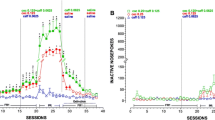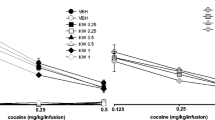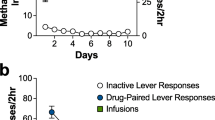Abstract
Rationale
Caffeine and the adenosine A1 and A2A receptor antagonist CGS15943 produce many behavioral effects that are similar to those produced by classic stimulant drugs (e.g. cocaine and amphetamines).
Objectives
The current study evaluated whether CGS15943 would maintain self-administration and reinstate extinguished lever responding previously maintained by cocaine (i.e. cocaine-seeking) or by food (i.e. food-seeking). Reinstatement with CGS15943 was compared to cocaine, caffeine, and alprazolam.
Methods
Up to 30 injections of 0.032 mg/kg cocaine or 30 deliveries of 1-g food pellets were available under a fixed ratio (FR10) schedule of reinforcement during daily 2-h sessions. For reinstatement tests, lever responses were extinguished by substituting saline for cocaine or by removing pellets from the mechanical feeder. After extinction of lever responding, acute "priming" doses (mg/kg, IV) of cocaine (0.1–3.2), the adenosine receptor antagonists caffeine (0.1–1.8) and CGS15943 (0.032–0.32) or the benzodiazepine receptor agonist alprazolam (0.1–1.8 mg/kg) were administered. The intravenous reinforcing effects of CGS15943 were also evaluated; each dose of CGS15943 (0.001–0.032 mg/kg) was substituted for cocaine for at least 10 days and until self-injection was relatively stable.
Results
Cocaine, caffeine and CGS15943, dose-dependently increased cocaine-seeking, where as alprazolam did not. Cocaine, caffeine and CGS15943 did not increase food-seeking. CGS15943 reinstated cocaine-seeking at rates that were comparable to those produced by cocaine. Pretreatment with the adenosine A2 agonist CGS21680 decreased CGS15943-induced reinstatement of cocaine-seeking. In self-injection testing, CGS15943 was self-administered at levels greater than vehicle. An inverted U-shaped dose-effect function was obtained with peak mean rates maintained by 0.01 mg/kg CGS15943.
Conclusions
The adenosine antagonist CGS15943 reinstated cocaine-seeking and functioned as an intravenous reinforcer. The finding that CGS21680 produced a rightward shift in the CGS15943 reinstatement dose-effect curve supports a role of adenosine mechanisms in the reinstatement of cocaine-seeking behavior.




Similar content being viewed by others
References
Bordens KS, Abbott BB (1996) Research design and methods: a process approach, 3rd edn. Mayfield
Carroll ME, Comer SD (1996) Animal models of relapse. Exp Clin Psychopharmacol 4:11–18
Comer SD, Carroll ME (1996) Oral caffeine pretreatment produced modest increases in smoked cocaine self-administration in rhesus monkeys. Psychopharmacology 126:281–285
Comer SD, Lac ST, Curtis LK, Carroll ME (1993) Effects of buprenorphine and naltrexone on reinstatement of cocaine-reinforced responding in rats. J Pharmacol Exp Ther 267:1470–1477
Davis WM, Smith SG (1976) Role of conditioned reinforcers in the initiation, maintenance, and extinction of drug-seeking behavior. Pavlov J Biol Sci 11:222–236
De Vries TJ, Schoffelmeer AN, Binnekade R, Vanderschuren LJ (1999) Dopaminergic mechanisms mediating the incentive to seek cocaine and heroin following long-term withdrawal of IV drug self-administration. Psychopharmacology 143:254–260
deWit H (1996) Priming effects with drugs and other reinforcers. Exp Clin Psychopharmacol 4:5–10
deWit H, Stewart J (1981) Reinstatement of cocaine-reinforced responding in the rat. Psychopharmacology 75:134–143
deWit H, Stewart J (1983) Drug reinstatement of heroin-reinforced responding in the rat. Psychopharmacology 79:29–31
Ferre S, Fuxe K, von Euler G, Johansson B, Fredholm BB (1992) Adenosine-dopamine interactions in the brain. Neuroscience 51:501–512
Ferre S, O'Connor WT, Snaprud P, Ungerstedt U, Fuxe K (1994a) Antagonistic interaction between adenosine A2A receptors and dopamine D2 receptors in the ventral striopallidal system. Implications for the treatment of schizophrenia. Neuroscience 63:765–773
Ferre S, Popoli P, Gimenez-Llort L, Finnman UB, Martinez E, Scotti de Carolis A, Fuxe K (1994b) Postsynaptic antagonistic interaction between adenosine A1 and dopamine D1 receptors. Neuroreport 6:73–76
Ferre S, Popoli P, Tinner-Staines B, Fuxe K (1996) Adenosine A1 receptor-dopamine D1 receptor interaction in the rat limbic system: modulation of dopamine D1 receptor antagonist binding sites. Neurosci Lett 208:109–112
Fredholm BB, Battig K, Holmen J, Nehlig A, Zvartau EE (1999) Actions of caffeine in the brain with special reference to factors that contribute to its widespread use. Pharmacol Rev 51:83–133
Garrett BE, Griffiths RR (1997) The role of dopamine in the behavioral effects of caffeine in animals and humans. Pharmacol Biochem Behav 57:533–541
Gauvin DV, Criado JR, Moore KR, Holloway FA (1990) Potentiation of cocaine's discriminative effects by caffeine: a time-effect analysis. Pharmacol Biochem Behav 36:195–197
Gerber GJ, Stretch R (1975) Drug-induced reinstatement of extinguished self-administration behavior in monkeys. Pharmacol Biochem Behav 3:1055–1061
Ghai G, Francis JE, Williams M, Dotson RA, Hopkins MF, Cote DT, Goodman FR, Zimmerman MB (1987) Pharmacological characterization of CGS 15943A: a novel nonxanthine adenosine antagonist. J Pharmacol Exp Ther 242:784–790
Green TA, Schenk S (2002) Dopaminergic mechanism for caffeine-produced cocaine seeking in rats. Neuropsychopharmacology 26:422–430
Griebel G, Saffroy-Spittler M, Misslin R, Remmy D, Vogel E, Bourguignon JJ (1991) Comparison of the behavioural effects of an adenosine A1/A2-receptor antagonist, CGS 15943A, and an A1-selective antagonist, DPCPX. Psychopharmacology 103:541–544
Griffiths RR, Lamb RJ, Sannerud CA, Ator NA, Brady JV (1991) Self-injection of barbiturates, benzodiazepines and other sedative- anxiolytics in baboons. Psychopharmacology 103:154–161
Holtzman SG (1991) CGS 15943, a nonxanthine adenosine receptor antagonist: effects on locomotor activity of nontolerant and caffeine-tolerant rats. Life Sci 49:1563–1570
Holtzman SG (1996) Discriminative effects of CGS 15943, a competitive adenosine receptor antagonist, in monkeys: comparison to methylxanthines. J Pharmacol Exp Ther 277:739–746
Holtzman SG (1999) Discriminative effects of CGS 15943, a competitive adenosine receptor antagonist, have a dopamine component in monkeys. Eur J Pharmacol 376:7–15
Horger BA, Wellman PJ, Morien A, Davies BT, Schenk S (1991) Caffeine exposure sensitizes rats to the reinforcing effects of cocaine. Neuroreport 2:53–56
Howell LL, Byrd LD (1993) Effects of CGS 15943, a nonxanthine adenosine antagonist, on behavior in the squirrel monkey. J Pharmacol Exp Ther 267:432–439
Howell LL, Coffin VL, Spealman RD (1997) Behavioral and physiological effects of xanthines in nonhuman primates. Psychopharmacology 129:1–14
Knapp CM, Foye MM, Cottam N, Ciraulo DA, Kornetsky C (2001) Adenosine agonists CGS 21680 and NECA inhibit the initiation of cocaine self-administration. Pharmacol Biochem Behav 68:797–803
Kuribara H (1994a) Caffeine enhances the stimulant effect of methamphetamine, but may not affect induction of methamphetamine sensitization of ambulation in mice. Psychopharmacology 116:125–129
Kuribara H (1994b) Modification by caffeine of the sensitization to methamphetamine and cocaine in terms of ambulation in mice. Life Sci 55:933–940
Kuzmin A, Johansson B, Zvartau EE, Fredholm BB (1999) Caffeine, acting on adenosine A(1) receptors, prevents the extinction of cocaine-seeking behavior in mice. J Pharmacol Exp Ther 290:535–542
Le AD, Quan B, Juzytch W, Fletcher PJ, Joharchi N, Shaham Y (1998) Reinstatement of alcohol-seeking by priming injections of alcohol and exposure to stress in rats. Psychopharmacology 135:169–174
Lukas SE, Griffiths RR, Bradford LD, Brady JV, Daley L (1982) A tethering system for intravenous and intragastric drug administration in the baboon. Pharmacol Biochem Behav 17:823–829
Markou A, Weiss F, Gold LH, Caine SB, Schulteis G, Koob GF (1993) Animal models of drug craving. Psychopharmacology 112:163–182
Mumford GK, Holtzman SG (1991) Qualitative differences in the discriminative stimulus effects of low and high doses of caffeine in the rat. J Pharmacol Exp Ther 258:857–865
Munzar P, Justinova Z, Kutkat SW, Ferre S, Goldberg SR (2002) Adenosinergic modulation of the discriminative-stimulus effects of methamphetamine in rats. Psychopharmacology 161:348–355
Schenk S, Partridge B (1999) Cocaine-seeking produced by experimenter-administered drug injections: dose-effect relationships in rats. Psychopharmacology 147:285–290
Schenk S, Horger B, Snow S (1990) Caffeine preexposure sensitizes rats to the motor activating effects of cocaine. Behav Pharmacol 1:447–451
Schenk S, Valadez A, Horger BA, Snow S, Wellman PJ (1994) Interactions between caffeine and cocaine in tests of self- administration. Behav Pharmacol 5:153–158
Schenk S, Worley CM, McNamara C, Valadez A (1996) Acute and repeated exposure to caffeine: effects on reinstatement of extinguished cocaine-taking behavior in rats. Psychopharmacology 126:17–23
Self DW (1998) Neural substrates of drug craving and relapse in drug addiction. Ann Med 30:379–389
Self DW, Barnhart WJ, Lehman DA, Nestler EJ (1996) Opposite modulation of cocaine-seeking behavior by D1- and D2-like dopamine receptor agonists [see comments]. Science 271:1586–1589
Shaham Y, Rajabi H, Stewart J (1996) Relapse to heroin-seeking in rats under opioid maintenance: the effects of stress, heroin priming, and withdrawal. J Neurosci 16:1957–1963
Shaham Y, Erb S, Stewart J (2000) Stress-induced relapse to heroin and cocaine seeking in rats: a review. Brain Res Brain Res Rev 33:13–33
Sidman M (1960) Tactics of scientific research. Basic Books
Slikker W Jr, Brocco MJ, Killam KF Jr (1984) Reinstatement of responding maintained by cocaine or thiamylal. J Pharmacol Exp Ther 228:43–52
Spealman RD (1988) Psychomotor stimulant effects of methylxanthines in squirrel monkeys: relation to adenosine antagonism. Psychopharmacology 95:19–24
Stretch R, Gerber GJ (1973) Drug-induced reinstatement of amphetamine self-administration in monkeys. Can J Psychol 27:168–177
Weerts EM, Griffiths RR (2002) Cocaine-seeking and self-administration in baboons: differential effects of baclofen. Drug Alcohol Depend 66:S191
Williams M, Francis J, Ghai G, Braunwalder A, Psychoyos S, Stone GA, Cash WD (1987) Biochemical characterization of the triazoloquinazoline, CGS 15943, a novel, non-xanthine adenosine antagonist. J Pharmacol Exp Ther 241:415–420
Worley CM, Valadez A, Schenk S (1994) Reinstatement of extinguished cocaine-taking behavior by cocaine and caffeine. Pharmacol Biochem Behav 48:217–221
Acknowledgements
The authors gratefully acknowledge the donations of cocaine by the Drug Supply Program of the National Institute on Drug Abuse (NIDA) and of CGS15943 by CIBA-GEIGY. This research was supported in part by NIDA grants R01 DA01147 (R.R.G.) and DA13621 (E.M.W.). The authors would like to thank Samuel Womack and Christine Ebaugh for excellent technical assistance.
Author information
Authors and Affiliations
Corresponding author
Rights and permissions
About this article
Cite this article
Weerts, E.M., Griffiths, R.R. The adenosine receptor antagonist CGS15943 reinstates cocaine-seeking behavior and maintains self-administration in baboons. Psychopharmacology 168, 155–163 (2003). https://doi.org/10.1007/s00213-003-1410-5
Received:
Accepted:
Published:
Issue Date:
DOI: https://doi.org/10.1007/s00213-003-1410-5




